Detailed Report: Cybersecurity Resilience Plan for Altium Limited
VerifiedAdded on 2023/06/07
|13
|3301
|210
Report
AI Summary
This report provides a comprehensive analysis of a cybersecurity resilience plan designed for Altium Limited, an ASX 200 company specializing in information security and IT outsourcing. It begins by differentiating cyber resilience from traditional cybersecurity approaches, highlighting the importance of data recovery and rapid response in the face of cyber threats. The report outlines the implementation framework, emphasizing the need to map relationships within the cyber ecosystem and develop attributes for resilience, including resilient leadership, culture, and networks. It also discusses the importance of a holistic approach involving all employees and the consolidation of log systems. Furthermore, the report delves into best practices, including establishing a resilient culture and change readiness, to ensure the plan's effectiveness. The report underscores the advantages of cyber resilience in terms of data backup and risk mitigation, making it a valuable resource for understanding and implementing robust cybersecurity strategies.
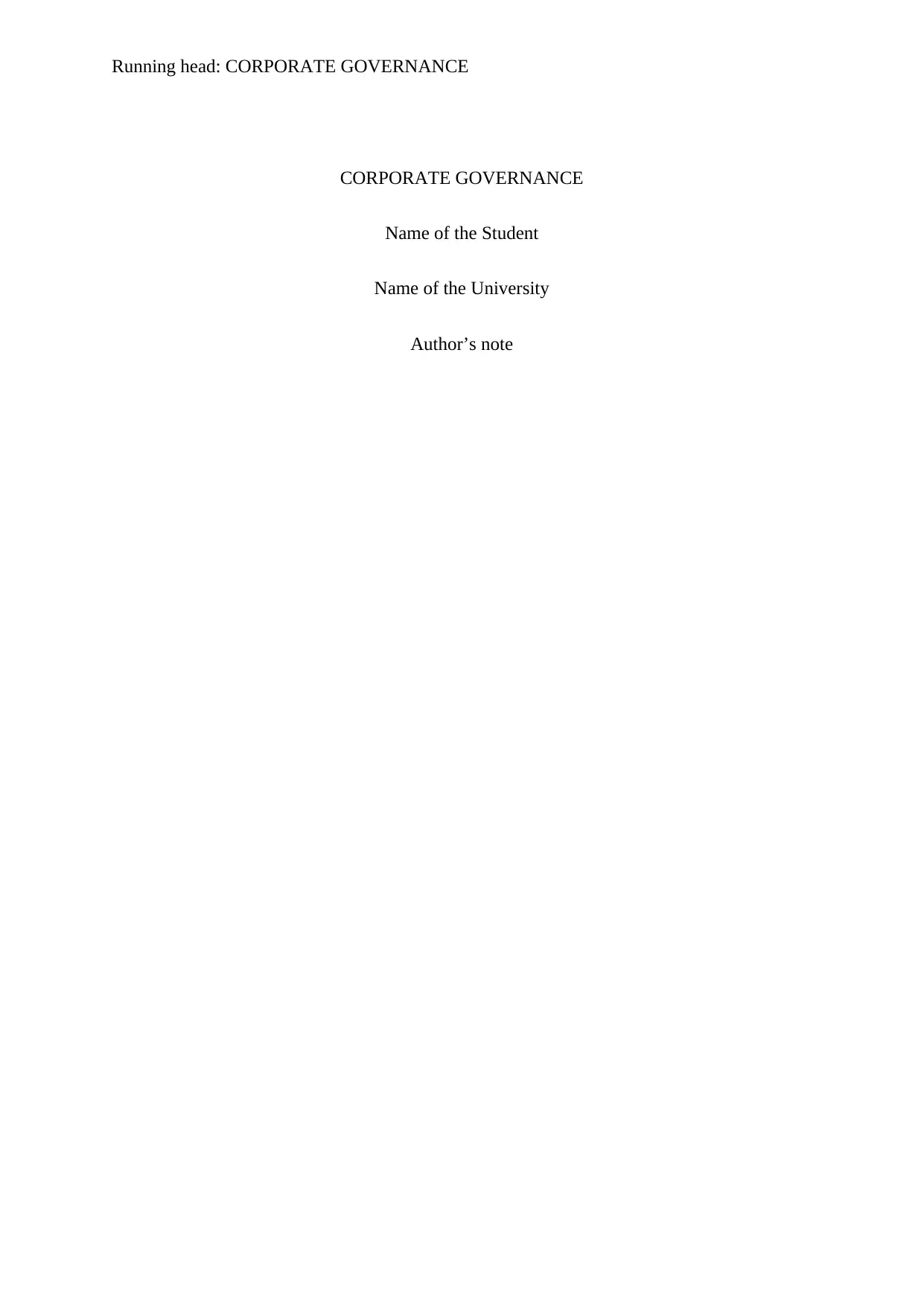
Running head: CORPORATE GOVERNANCE
CORPORATE GOVERNANCE
Name of the Student
Name of the University
Author’s note
CORPORATE GOVERNANCE
Name of the Student
Name of the University
Author’s note
Paraphrase This Document
Need a fresh take? Get an instant paraphrase of this document with our AI Paraphraser
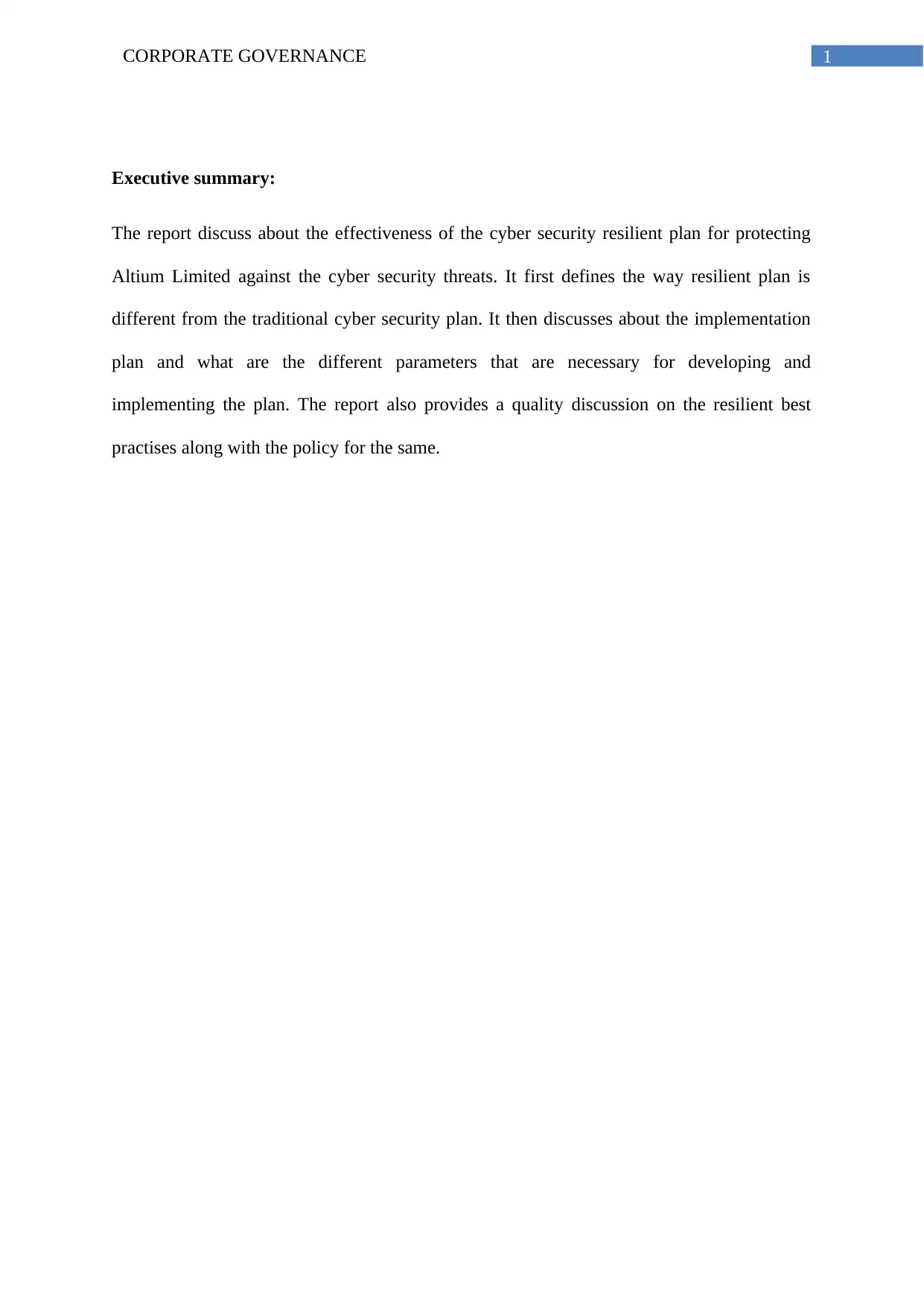
1CORPORATE GOVERNANCE
Executive summary:
The report discuss about the effectiveness of the cyber security resilient plan for protecting
Altium Limited against the cyber security threats. It first defines the way resilient plan is
different from the traditional cyber security plan. It then discusses about the implementation
plan and what are the different parameters that are necessary for developing and
implementing the plan. The report also provides a quality discussion on the resilient best
practises along with the policy for the same.
Executive summary:
The report discuss about the effectiveness of the cyber security resilient plan for protecting
Altium Limited against the cyber security threats. It first defines the way resilient plan is
different from the traditional cyber security plan. It then discusses about the implementation
plan and what are the different parameters that are necessary for developing and
implementing the plan. The report also provides a quality discussion on the resilient best
practises along with the policy for the same.
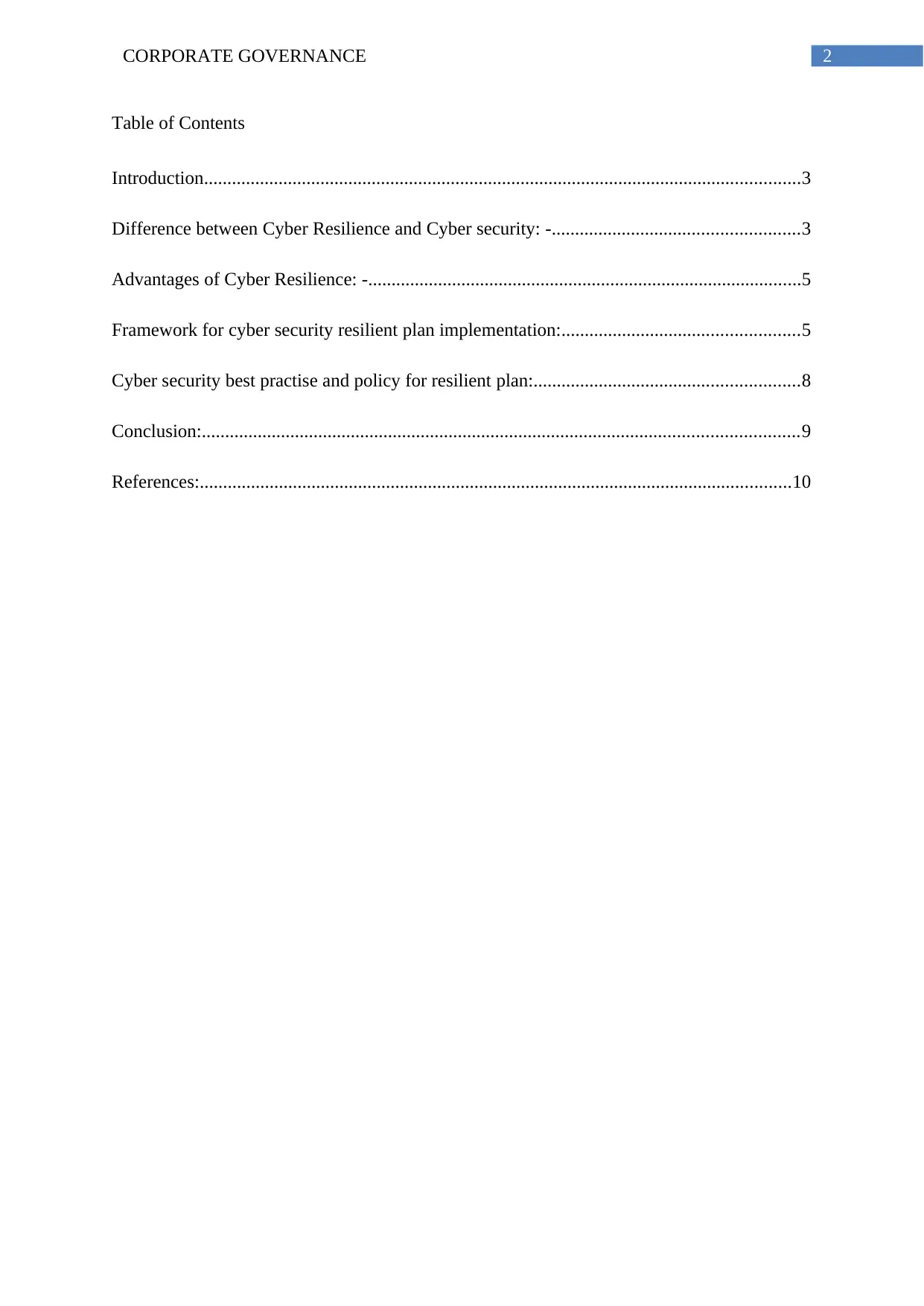
2CORPORATE GOVERNANCE
Table of Contents
Introduction................................................................................................................................3
Difference between Cyber Resilience and Cyber security: -.....................................................3
Advantages of Cyber Resilience: -.............................................................................................5
Framework for cyber security resilient plan implementation:...................................................5
Cyber security best practise and policy for resilient plan:.........................................................8
Conclusion:................................................................................................................................9
References:...............................................................................................................................10
Table of Contents
Introduction................................................................................................................................3
Difference between Cyber Resilience and Cyber security: -.....................................................3
Advantages of Cyber Resilience: -.............................................................................................5
Framework for cyber security resilient plan implementation:...................................................5
Cyber security best practise and policy for resilient plan:.........................................................8
Conclusion:................................................................................................................................9
References:...............................................................................................................................10
⊘ This is a preview!⊘
Do you want full access?
Subscribe today to unlock all pages.

Trusted by 1+ million students worldwide
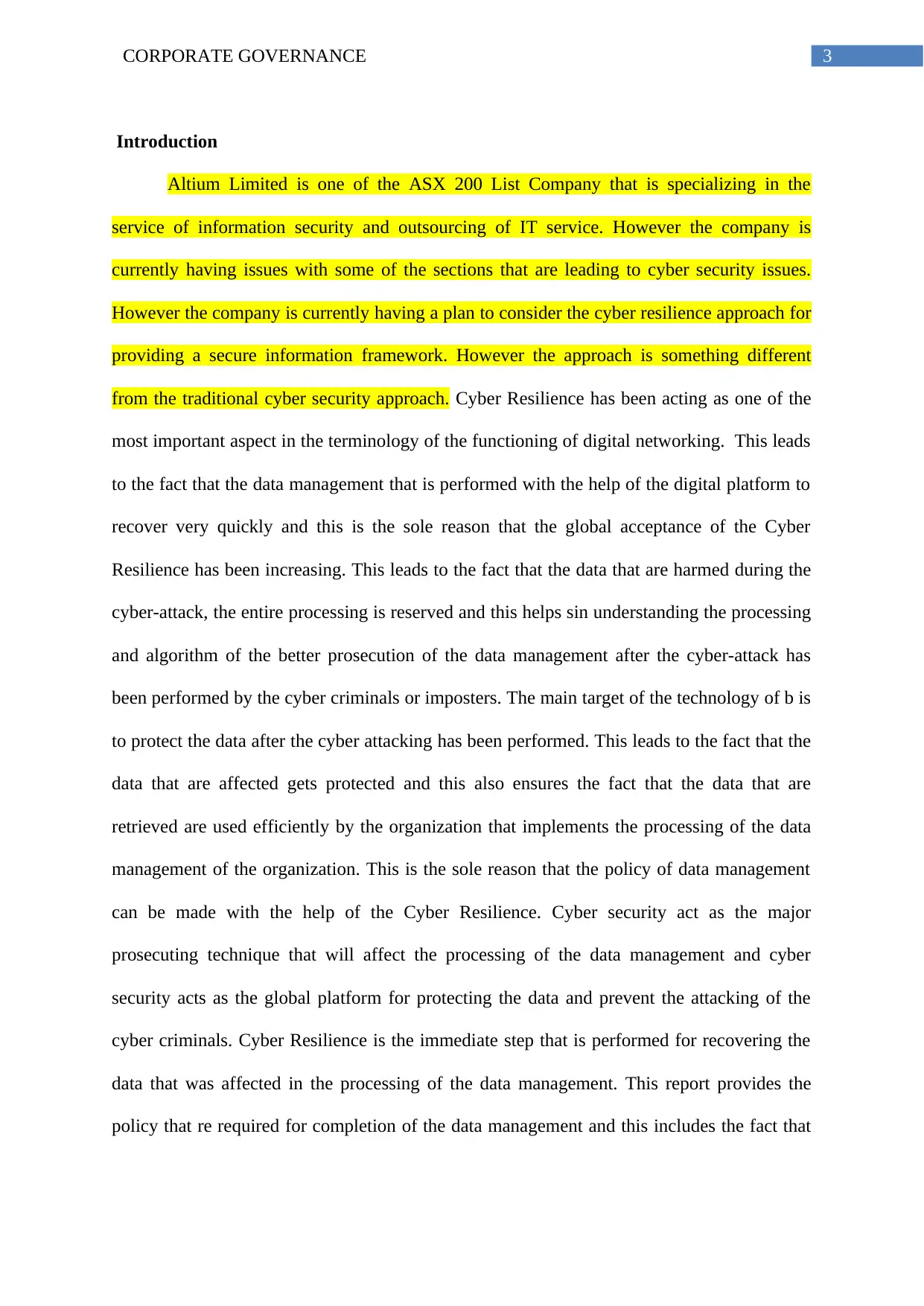
3CORPORATE GOVERNANCE
Introduction
Altium Limited is one of the ASX 200 List Company that is specializing in the
service of information security and outsourcing of IT service. However the company is
currently having issues with some of the sections that are leading to cyber security issues.
However the company is currently having a plan to consider the cyber resilience approach for
providing a secure information framework. However the approach is something different
from the traditional cyber security approach. Cyber Resilience has been acting as one of the
most important aspect in the terminology of the functioning of digital networking. This leads
to the fact that the data management that is performed with the help of the digital platform to
recover very quickly and this is the sole reason that the global acceptance of the Cyber
Resilience has been increasing. This leads to the fact that the data that are harmed during the
cyber-attack, the entire processing is reserved and this helps sin understanding the processing
and algorithm of the better prosecution of the data management after the cyber-attack has
been performed by the cyber criminals or imposters. The main target of the technology of b is
to protect the data after the cyber attacking has been performed. This leads to the fact that the
data that are affected gets protected and this also ensures the fact that the data that are
retrieved are used efficiently by the organization that implements the processing of the data
management of the organization. This is the sole reason that the policy of data management
can be made with the help of the Cyber Resilience. Cyber security act as the major
prosecuting technique that will affect the processing of the data management and cyber
security acts as the global platform for protecting the data and prevent the attacking of the
cyber criminals. Cyber Resilience is the immediate step that is performed for recovering the
data that was affected in the processing of the data management. This report provides the
policy that re required for completion of the data management and this includes the fact that
Introduction
Altium Limited is one of the ASX 200 List Company that is specializing in the
service of information security and outsourcing of IT service. However the company is
currently having issues with some of the sections that are leading to cyber security issues.
However the company is currently having a plan to consider the cyber resilience approach for
providing a secure information framework. However the approach is something different
from the traditional cyber security approach. Cyber Resilience has been acting as one of the
most important aspect in the terminology of the functioning of digital networking. This leads
to the fact that the data management that is performed with the help of the digital platform to
recover very quickly and this is the sole reason that the global acceptance of the Cyber
Resilience has been increasing. This leads to the fact that the data that are harmed during the
cyber-attack, the entire processing is reserved and this helps sin understanding the processing
and algorithm of the better prosecution of the data management after the cyber-attack has
been performed by the cyber criminals or imposters. The main target of the technology of b is
to protect the data after the cyber attacking has been performed. This leads to the fact that the
data that are affected gets protected and this also ensures the fact that the data that are
retrieved are used efficiently by the organization that implements the processing of the data
management of the organization. This is the sole reason that the policy of data management
can be made with the help of the Cyber Resilience. Cyber security act as the major
prosecuting technique that will affect the processing of the data management and cyber
security acts as the global platform for protecting the data and prevent the attacking of the
cyber criminals. Cyber Resilience is the immediate step that is performed for recovering the
data that was affected in the processing of the data management. This report provides the
policy that re required for completion of the data management and this includes the fact that
Paraphrase This Document
Need a fresh take? Get an instant paraphrase of this document with our AI Paraphraser
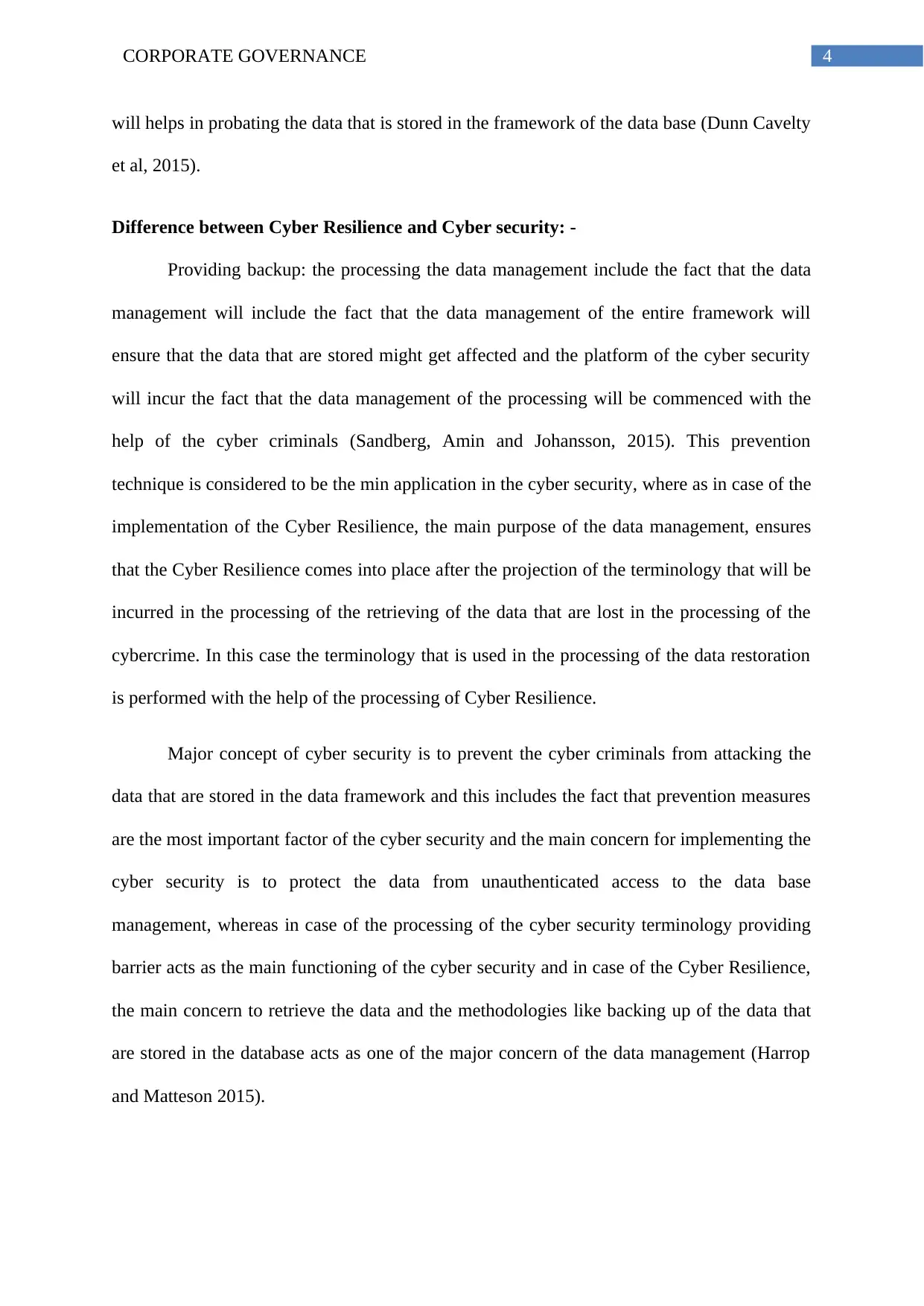
4CORPORATE GOVERNANCE
will helps in probating the data that is stored in the framework of the data base (Dunn Cavelty
et al, 2015).
Difference between Cyber Resilience and Cyber security: -
Providing backup: the processing the data management include the fact that the data
management will include the fact that the data management of the entire framework will
ensure that the data that are stored might get affected and the platform of the cyber security
will incur the fact that the data management of the processing will be commenced with the
help of the cyber criminals (Sandberg, Amin and Johansson, 2015). This prevention
technique is considered to be the min application in the cyber security, where as in case of the
implementation of the Cyber Resilience, the main purpose of the data management, ensures
that the Cyber Resilience comes into place after the projection of the terminology that will be
incurred in the processing of the retrieving of the data that are lost in the processing of the
cybercrime. In this case the terminology that is used in the processing of the data restoration
is performed with the help of the processing of Cyber Resilience.
Major concept of cyber security is to prevent the cyber criminals from attacking the
data that are stored in the data framework and this includes the fact that prevention measures
are the most important factor of the cyber security and the main concern for implementing the
cyber security is to protect the data from unauthenticated access to the data base
management, whereas in case of the processing of the cyber security terminology providing
barrier acts as the main functioning of the cyber security and in case of the Cyber Resilience,
the main concern to retrieve the data and the methodologies like backing up of the data that
are stored in the database acts as one of the major concern of the data management (Harrop
and Matteson 2015).
will helps in probating the data that is stored in the framework of the data base (Dunn Cavelty
et al, 2015).
Difference between Cyber Resilience and Cyber security: -
Providing backup: the processing the data management include the fact that the data
management will include the fact that the data management of the entire framework will
ensure that the data that are stored might get affected and the platform of the cyber security
will incur the fact that the data management of the processing will be commenced with the
help of the cyber criminals (Sandberg, Amin and Johansson, 2015). This prevention
technique is considered to be the min application in the cyber security, where as in case of the
implementation of the Cyber Resilience, the main purpose of the data management, ensures
that the Cyber Resilience comes into place after the projection of the terminology that will be
incurred in the processing of the retrieving of the data that are lost in the processing of the
cybercrime. In this case the terminology that is used in the processing of the data restoration
is performed with the help of the processing of Cyber Resilience.
Major concept of cyber security is to prevent the cyber criminals from attacking the
data that are stored in the data framework and this includes the fact that prevention measures
are the most important factor of the cyber security and the main concern for implementing the
cyber security is to protect the data from unauthenticated access to the data base
management, whereas in case of the processing of the cyber security terminology providing
barrier acts as the main functioning of the cyber security and in case of the Cyber Resilience,
the main concern to retrieve the data and the methodologies like backing up of the data that
are stored in the database acts as one of the major concern of the data management (Harrop
and Matteson 2015).
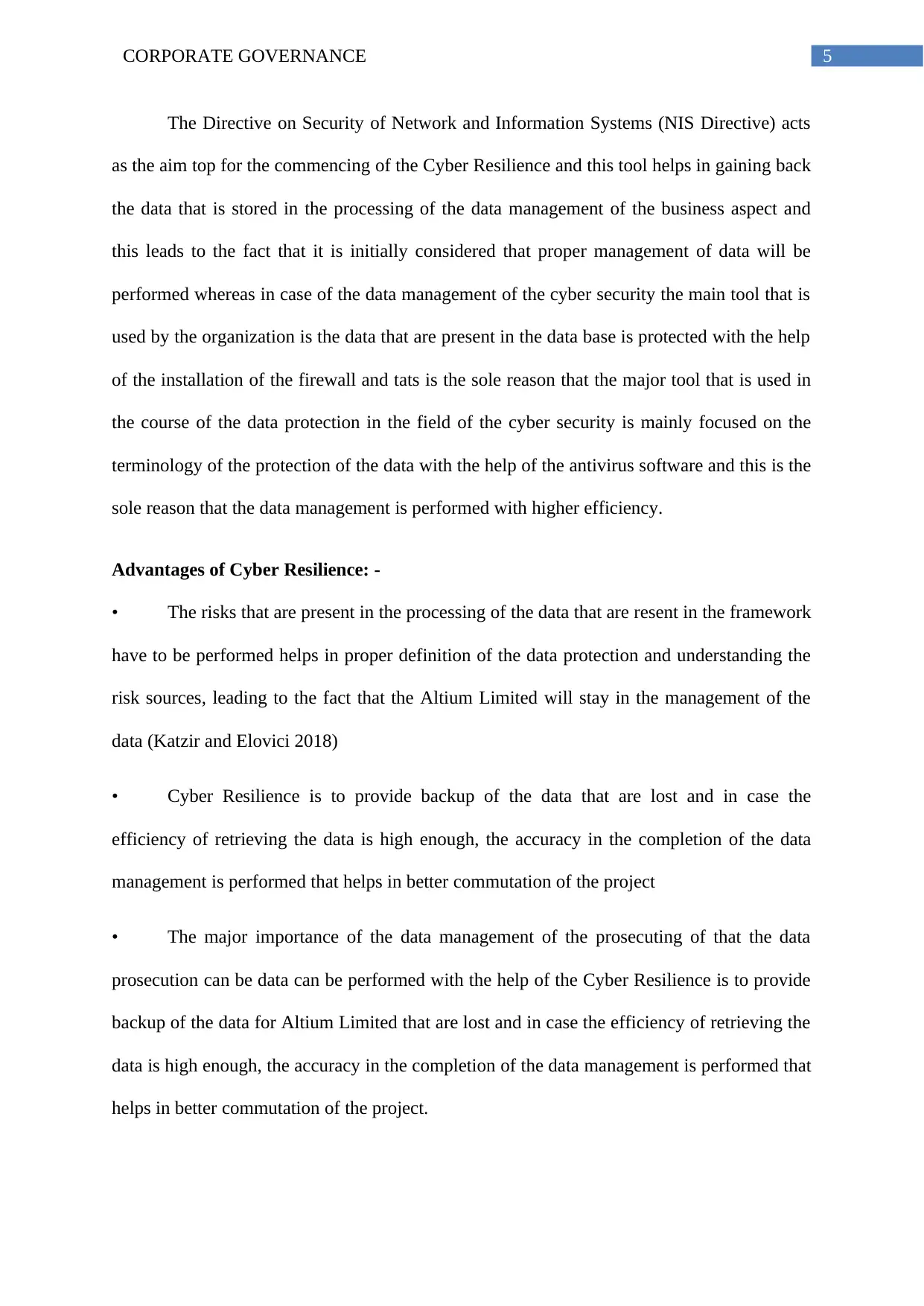
5CORPORATE GOVERNANCE
The Directive on Security of Network and Information Systems (NIS Directive) acts
as the aim top for the commencing of the Cyber Resilience and this tool helps in gaining back
the data that is stored in the processing of the data management of the business aspect and
this leads to the fact that it is initially considered that proper management of data will be
performed whereas in case of the data management of the cyber security the main tool that is
used by the organization is the data that are present in the data base is protected with the help
of the installation of the firewall and tats is the sole reason that the major tool that is used in
the course of the data protection in the field of the cyber security is mainly focused on the
terminology of the protection of the data with the help of the antivirus software and this is the
sole reason that the data management is performed with higher efficiency.
Advantages of Cyber Resilience: -
• The risks that are present in the processing of the data that are resent in the framework
have to be performed helps in proper definition of the data protection and understanding the
risk sources, leading to the fact that the Altium Limited will stay in the management of the
data (Katzir and Elovici 2018)
• Cyber Resilience is to provide backup of the data that are lost and in case the
efficiency of retrieving the data is high enough, the accuracy in the completion of the data
management is performed that helps in better commutation of the project
• The major importance of the data management of the prosecuting of that the data
prosecution can be data can be performed with the help of the Cyber Resilience is to provide
backup of the data for Altium Limited that are lost and in case the efficiency of retrieving the
data is high enough, the accuracy in the completion of the data management is performed that
helps in better commutation of the project.
The Directive on Security of Network and Information Systems (NIS Directive) acts
as the aim top for the commencing of the Cyber Resilience and this tool helps in gaining back
the data that is stored in the processing of the data management of the business aspect and
this leads to the fact that it is initially considered that proper management of data will be
performed whereas in case of the data management of the cyber security the main tool that is
used by the organization is the data that are present in the data base is protected with the help
of the installation of the firewall and tats is the sole reason that the major tool that is used in
the course of the data protection in the field of the cyber security is mainly focused on the
terminology of the protection of the data with the help of the antivirus software and this is the
sole reason that the data management is performed with higher efficiency.
Advantages of Cyber Resilience: -
• The risks that are present in the processing of the data that are resent in the framework
have to be performed helps in proper definition of the data protection and understanding the
risk sources, leading to the fact that the Altium Limited will stay in the management of the
data (Katzir and Elovici 2018)
• Cyber Resilience is to provide backup of the data that are lost and in case the
efficiency of retrieving the data is high enough, the accuracy in the completion of the data
management is performed that helps in better commutation of the project
• The major importance of the data management of the prosecuting of that the data
prosecution can be data can be performed with the help of the Cyber Resilience is to provide
backup of the data for Altium Limited that are lost and in case the efficiency of retrieving the
data is high enough, the accuracy in the completion of the data management is performed that
helps in better commutation of the project.
⊘ This is a preview!⊘
Do you want full access?
Subscribe today to unlock all pages.

Trusted by 1+ million students worldwide
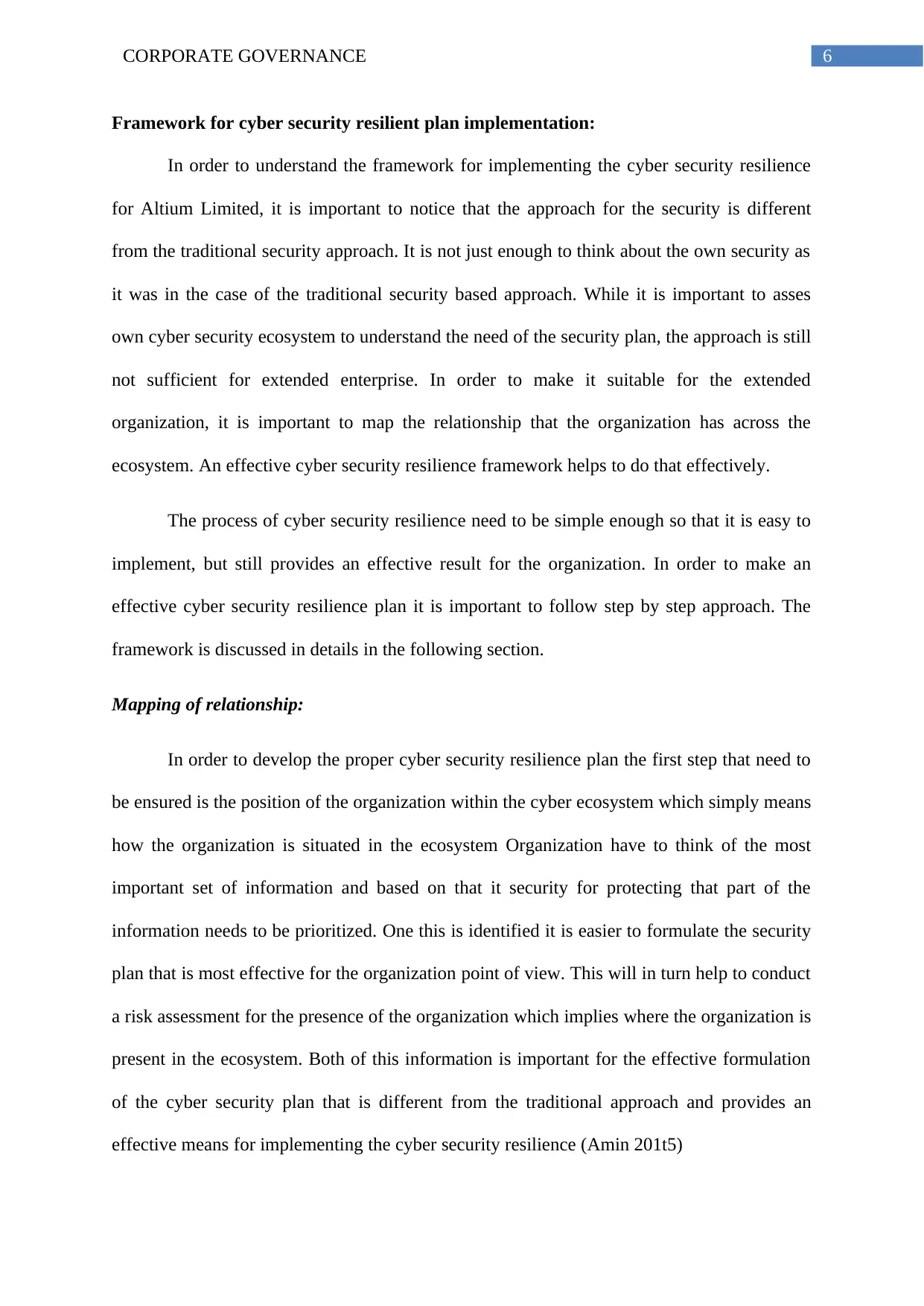
6CORPORATE GOVERNANCE
Framework for cyber security resilient plan implementation:
In order to understand the framework for implementing the cyber security resilience
for Altium Limited, it is important to notice that the approach for the security is different
from the traditional security approach. It is not just enough to think about the own security as
it was in the case of the traditional security based approach. While it is important to asses
own cyber security ecosystem to understand the need of the security plan, the approach is still
not sufficient for extended enterprise. In order to make it suitable for the extended
organization, it is important to map the relationship that the organization has across the
ecosystem. An effective cyber security resilience framework helps to do that effectively.
The process of cyber security resilience need to be simple enough so that it is easy to
implement, but still provides an effective result for the organization. In order to make an
effective cyber security resilience plan it is important to follow step by step approach. The
framework is discussed in details in the following section.
Mapping of relationship:
In order to develop the proper cyber security resilience plan the first step that need to
be ensured is the position of the organization within the cyber ecosystem which simply means
how the organization is situated in the ecosystem Organization have to think of the most
important set of information and based on that it security for protecting that part of the
information needs to be prioritized. One this is identified it is easier to formulate the security
plan that is most effective for the organization point of view. This will in turn help to conduct
a risk assessment for the presence of the organization which implies where the organization is
present in the ecosystem. Both of this information is important for the effective formulation
of the cyber security plan that is different from the traditional approach and provides an
effective means for implementing the cyber security resilience (Amin 201t5)
Framework for cyber security resilient plan implementation:
In order to understand the framework for implementing the cyber security resilience
for Altium Limited, it is important to notice that the approach for the security is different
from the traditional security approach. It is not just enough to think about the own security as
it was in the case of the traditional security based approach. While it is important to asses
own cyber security ecosystem to understand the need of the security plan, the approach is still
not sufficient for extended enterprise. In order to make it suitable for the extended
organization, it is important to map the relationship that the organization has across the
ecosystem. An effective cyber security resilience framework helps to do that effectively.
The process of cyber security resilience need to be simple enough so that it is easy to
implement, but still provides an effective result for the organization. In order to make an
effective cyber security resilience plan it is important to follow step by step approach. The
framework is discussed in details in the following section.
Mapping of relationship:
In order to develop the proper cyber security resilience plan the first step that need to
be ensured is the position of the organization within the cyber ecosystem which simply means
how the organization is situated in the ecosystem Organization have to think of the most
important set of information and based on that it security for protecting that part of the
information needs to be prioritized. One this is identified it is easier to formulate the security
plan that is most effective for the organization point of view. This will in turn help to conduct
a risk assessment for the presence of the organization which implies where the organization is
present in the ecosystem. Both of this information is important for the effective formulation
of the cyber security plan that is different from the traditional approach and provides an
effective means for implementing the cyber security resilience (Amin 201t5)
Paraphrase This Document
Need a fresh take? Get an instant paraphrase of this document with our AI Paraphraser
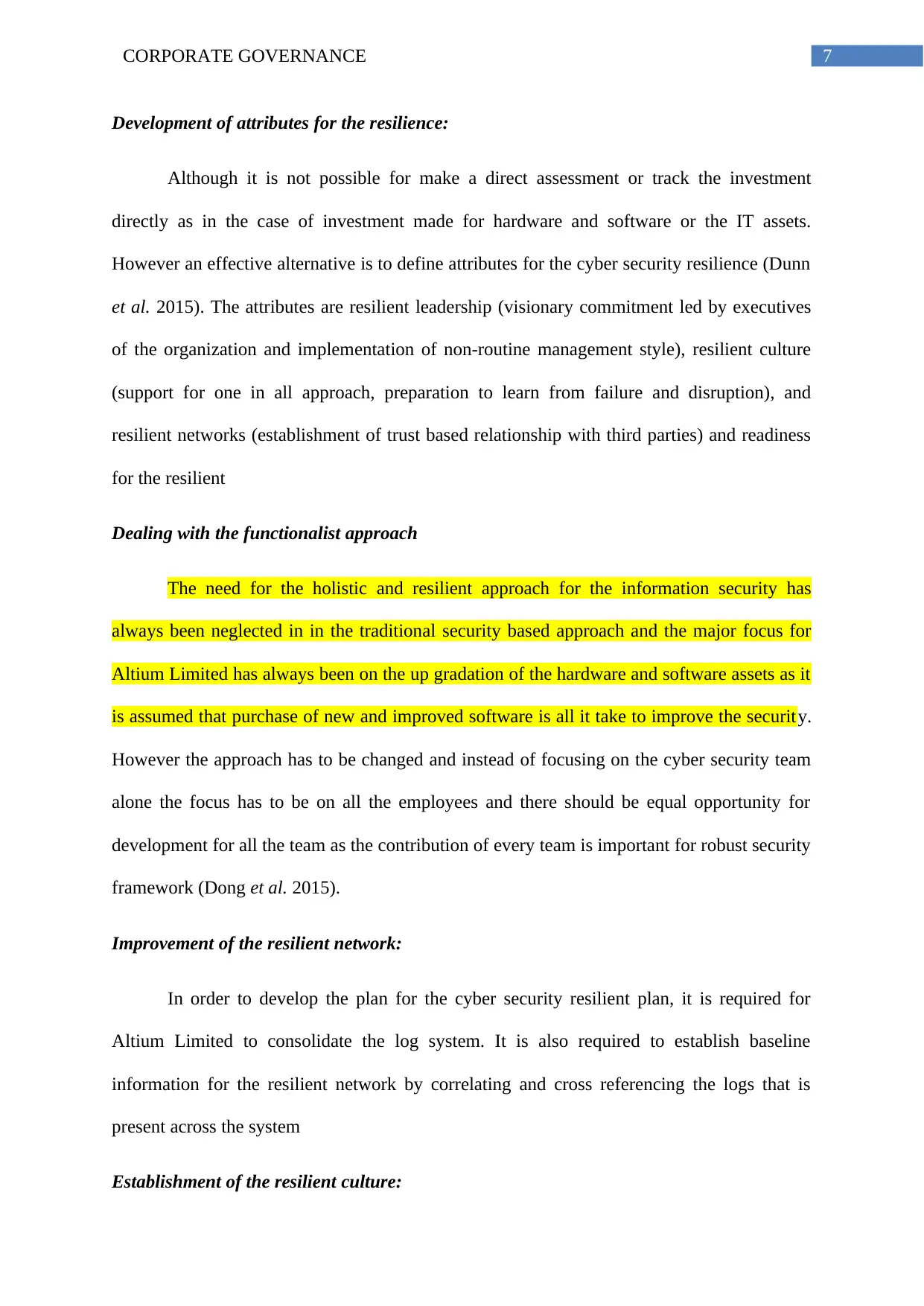
7CORPORATE GOVERNANCE
Development of attributes for the resilience:
Although it is not possible for make a direct assessment or track the investment
directly as in the case of investment made for hardware and software or the IT assets.
However an effective alternative is to define attributes for the cyber security resilience (Dunn
et al. 2015). The attributes are resilient leadership (visionary commitment led by executives
of the organization and implementation of non-routine management style), resilient culture
(support for one in all approach, preparation to learn from failure and disruption), and
resilient networks (establishment of trust based relationship with third parties) and readiness
for the resilient
Dealing with the functionalist approach
The need for the holistic and resilient approach for the information security has
always been neglected in in the traditional security based approach and the major focus for
Altium Limited has always been on the up gradation of the hardware and software assets as it
is assumed that purchase of new and improved software is all it take to improve the security.
However the approach has to be changed and instead of focusing on the cyber security team
alone the focus has to be on all the employees and there should be equal opportunity for
development for all the team as the contribution of every team is important for robust security
framework (Dong et al. 2015).
Improvement of the resilient network:
In order to develop the plan for the cyber security resilient plan, it is required for
Altium Limited to consolidate the log system. It is also required to establish baseline
information for the resilient network by correlating and cross referencing the logs that is
present across the system
Establishment of the resilient culture:
Development of attributes for the resilience:
Although it is not possible for make a direct assessment or track the investment
directly as in the case of investment made for hardware and software or the IT assets.
However an effective alternative is to define attributes for the cyber security resilience (Dunn
et al. 2015). The attributes are resilient leadership (visionary commitment led by executives
of the organization and implementation of non-routine management style), resilient culture
(support for one in all approach, preparation to learn from failure and disruption), and
resilient networks (establishment of trust based relationship with third parties) and readiness
for the resilient
Dealing with the functionalist approach
The need for the holistic and resilient approach for the information security has
always been neglected in in the traditional security based approach and the major focus for
Altium Limited has always been on the up gradation of the hardware and software assets as it
is assumed that purchase of new and improved software is all it take to improve the security.
However the approach has to be changed and instead of focusing on the cyber security team
alone the focus has to be on all the employees and there should be equal opportunity for
development for all the team as the contribution of every team is important for robust security
framework (Dong et al. 2015).
Improvement of the resilient network:
In order to develop the plan for the cyber security resilient plan, it is required for
Altium Limited to consolidate the log system. It is also required to establish baseline
information for the resilient network by correlating and cross referencing the logs that is
present across the system
Establishment of the resilient culture:
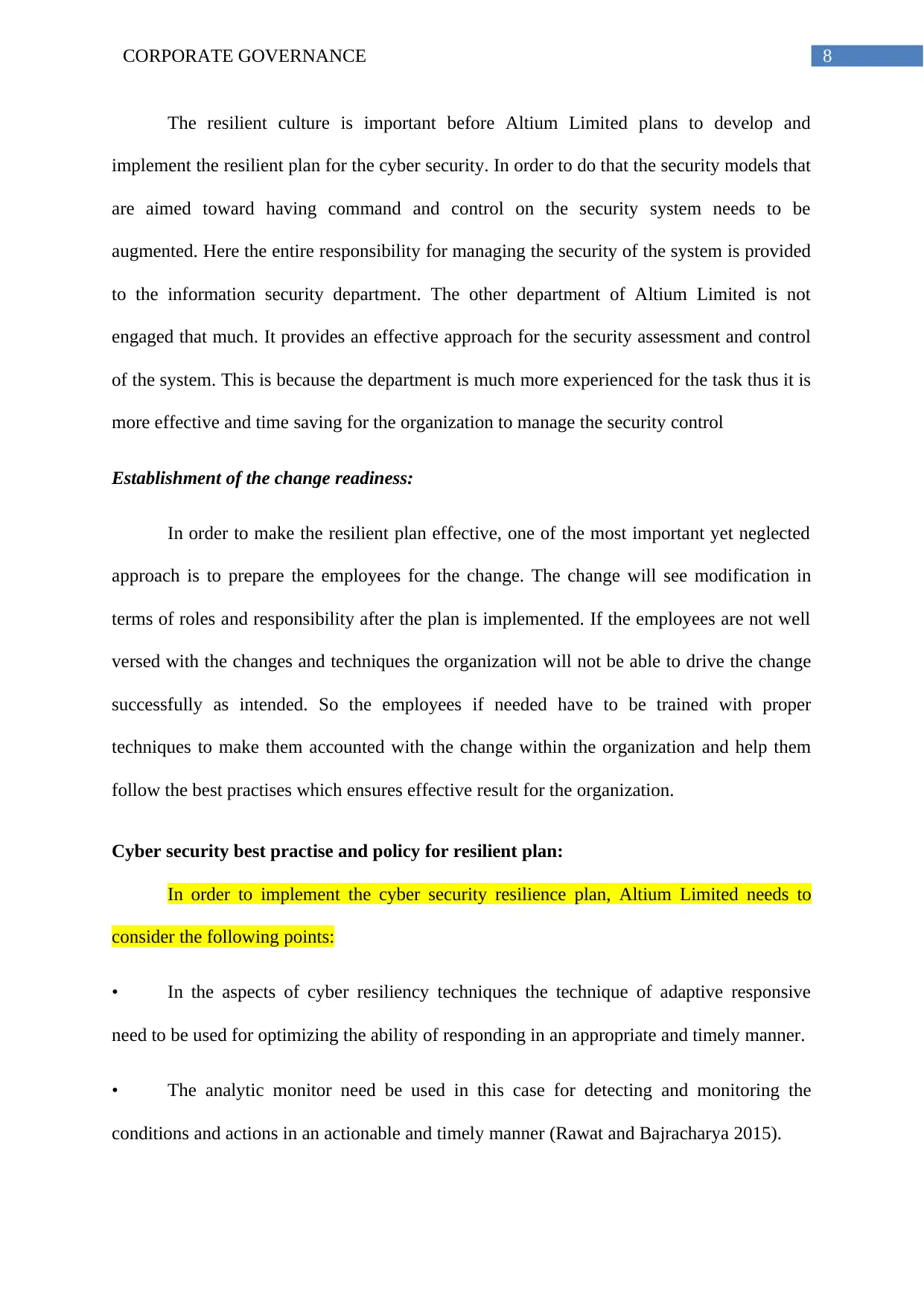
8CORPORATE GOVERNANCE
The resilient culture is important before Altium Limited plans to develop and
implement the resilient plan for the cyber security. In order to do that the security models that
are aimed toward having command and control on the security system needs to be
augmented. Here the entire responsibility for managing the security of the system is provided
to the information security department. The other department of Altium Limited is not
engaged that much. It provides an effective approach for the security assessment and control
of the system. This is because the department is much more experienced for the task thus it is
more effective and time saving for the organization to manage the security control
Establishment of the change readiness:
In order to make the resilient plan effective, one of the most important yet neglected
approach is to prepare the employees for the change. The change will see modification in
terms of roles and responsibility after the plan is implemented. If the employees are not well
versed with the changes and techniques the organization will not be able to drive the change
successfully as intended. So the employees if needed have to be trained with proper
techniques to make them accounted with the change within the organization and help them
follow the best practises which ensures effective result for the organization.
Cyber security best practise and policy for resilient plan:
In order to implement the cyber security resilience plan, Altium Limited needs to
consider the following points:
• In the aspects of cyber resiliency techniques the technique of adaptive responsive
need to be used for optimizing the ability of responding in an appropriate and timely manner.
• The analytic monitor need be used in this case for detecting and monitoring the
conditions and actions in an actionable and timely manner (Rawat and Bajracharya 2015).
The resilient culture is important before Altium Limited plans to develop and
implement the resilient plan for the cyber security. In order to do that the security models that
are aimed toward having command and control on the security system needs to be
augmented. Here the entire responsibility for managing the security of the system is provided
to the information security department. The other department of Altium Limited is not
engaged that much. It provides an effective approach for the security assessment and control
of the system. This is because the department is much more experienced for the task thus it is
more effective and time saving for the organization to manage the security control
Establishment of the change readiness:
In order to make the resilient plan effective, one of the most important yet neglected
approach is to prepare the employees for the change. The change will see modification in
terms of roles and responsibility after the plan is implemented. If the employees are not well
versed with the changes and techniques the organization will not be able to drive the change
successfully as intended. So the employees if needed have to be trained with proper
techniques to make them accounted with the change within the organization and help them
follow the best practises which ensures effective result for the organization.
Cyber security best practise and policy for resilient plan:
In order to implement the cyber security resilience plan, Altium Limited needs to
consider the following points:
• In the aspects of cyber resiliency techniques the technique of adaptive responsive
need to be used for optimizing the ability of responding in an appropriate and timely manner.
• The analytic monitor need be used in this case for detecting and monitoring the
conditions and actions in an actionable and timely manner (Rawat and Bajracharya 2015).
⊘ This is a preview!⊘
Do you want full access?
Subscribe today to unlock all pages.

Trusted by 1+ million students worldwide
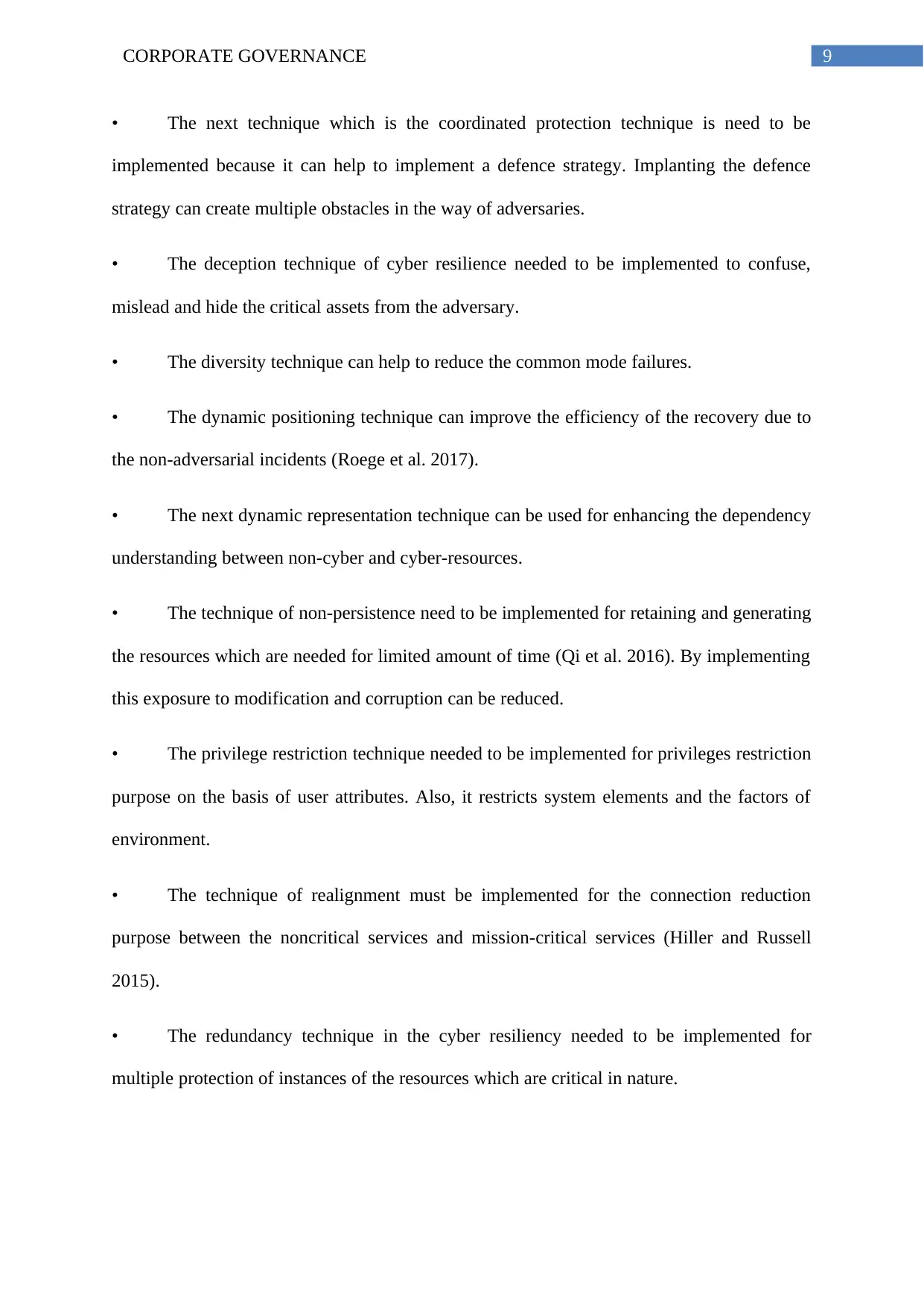
9CORPORATE GOVERNANCE
• The next technique which is the coordinated protection technique is need to be
implemented because it can help to implement a defence strategy. Implanting the defence
strategy can create multiple obstacles in the way of adversaries.
• The deception technique of cyber resilience needed to be implemented to confuse,
mislead and hide the critical assets from the adversary.
• The diversity technique can help to reduce the common mode failures.
• The dynamic positioning technique can improve the efficiency of the recovery due to
the non-adversarial incidents (Roege et al. 2017).
• The next dynamic representation technique can be used for enhancing the dependency
understanding between non-cyber and cyber-resources.
• The technique of non-persistence need to be implemented for retaining and generating
the resources which are needed for limited amount of time (Qi et al. 2016). By implementing
this exposure to modification and corruption can be reduced.
• The privilege restriction technique needed to be implemented for privileges restriction
purpose on the basis of user attributes. Also, it restricts system elements and the factors of
environment.
• The technique of realignment must be implemented for the connection reduction
purpose between the noncritical services and mission-critical services (Hiller and Russell
2015).
• The redundancy technique in the cyber resiliency needed to be implemented for
multiple protection of instances of the resources which are critical in nature.
• The next technique which is the coordinated protection technique is need to be
implemented because it can help to implement a defence strategy. Implanting the defence
strategy can create multiple obstacles in the way of adversaries.
• The deception technique of cyber resilience needed to be implemented to confuse,
mislead and hide the critical assets from the adversary.
• The diversity technique can help to reduce the common mode failures.
• The dynamic positioning technique can improve the efficiency of the recovery due to
the non-adversarial incidents (Roege et al. 2017).
• The next dynamic representation technique can be used for enhancing the dependency
understanding between non-cyber and cyber-resources.
• The technique of non-persistence need to be implemented for retaining and generating
the resources which are needed for limited amount of time (Qi et al. 2016). By implementing
this exposure to modification and corruption can be reduced.
• The privilege restriction technique needed to be implemented for privileges restriction
purpose on the basis of user attributes. Also, it restricts system elements and the factors of
environment.
• The technique of realignment must be implemented for the connection reduction
purpose between the noncritical services and mission-critical services (Hiller and Russell
2015).
• The redundancy technique in the cyber resiliency needed to be implemented for
multiple protection of instances of the resources which are critical in nature.
Paraphrase This Document
Need a fresh take? Get an instant paraphrase of this document with our AI Paraphraser
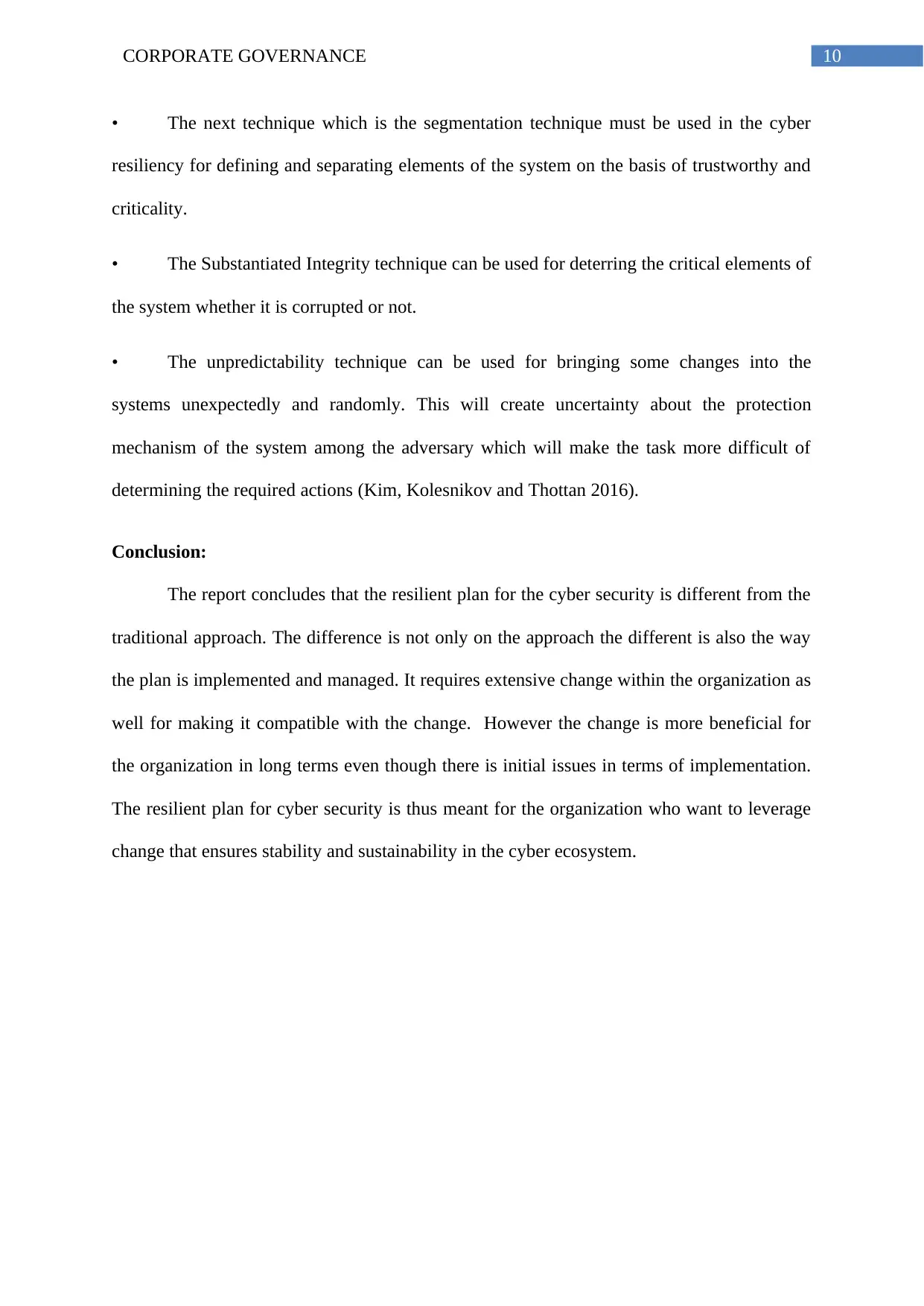
10CORPORATE GOVERNANCE
• The next technique which is the segmentation technique must be used in the cyber
resiliency for defining and separating elements of the system on the basis of trustworthy and
criticality.
• The Substantiated Integrity technique can be used for deterring the critical elements of
the system whether it is corrupted or not.
• The unpredictability technique can be used for bringing some changes into the
systems unexpectedly and randomly. This will create uncertainty about the protection
mechanism of the system among the adversary which will make the task more difficult of
determining the required actions (Kim, Kolesnikov and Thottan 2016).
Conclusion:
The report concludes that the resilient plan for the cyber security is different from the
traditional approach. The difference is not only on the approach the different is also the way
the plan is implemented and managed. It requires extensive change within the organization as
well for making it compatible with the change. However the change is more beneficial for
the organization in long terms even though there is initial issues in terms of implementation.
The resilient plan for cyber security is thus meant for the organization who want to leverage
change that ensures stability and sustainability in the cyber ecosystem.
• The next technique which is the segmentation technique must be used in the cyber
resiliency for defining and separating elements of the system on the basis of trustworthy and
criticality.
• The Substantiated Integrity technique can be used for deterring the critical elements of
the system whether it is corrupted or not.
• The unpredictability technique can be used for bringing some changes into the
systems unexpectedly and randomly. This will create uncertainty about the protection
mechanism of the system among the adversary which will make the task more difficult of
determining the required actions (Kim, Kolesnikov and Thottan 2016).
Conclusion:
The report concludes that the resilient plan for the cyber security is different from the
traditional approach. The difference is not only on the approach the different is also the way
the plan is implemented and managed. It requires extensive change within the organization as
well for making it compatible with the change. However the change is more beneficial for
the organization in long terms even though there is initial issues in terms of implementation.
The resilient plan for cyber security is thus meant for the organization who want to leverage
change that ensures stability and sustainability in the cyber ecosystem.
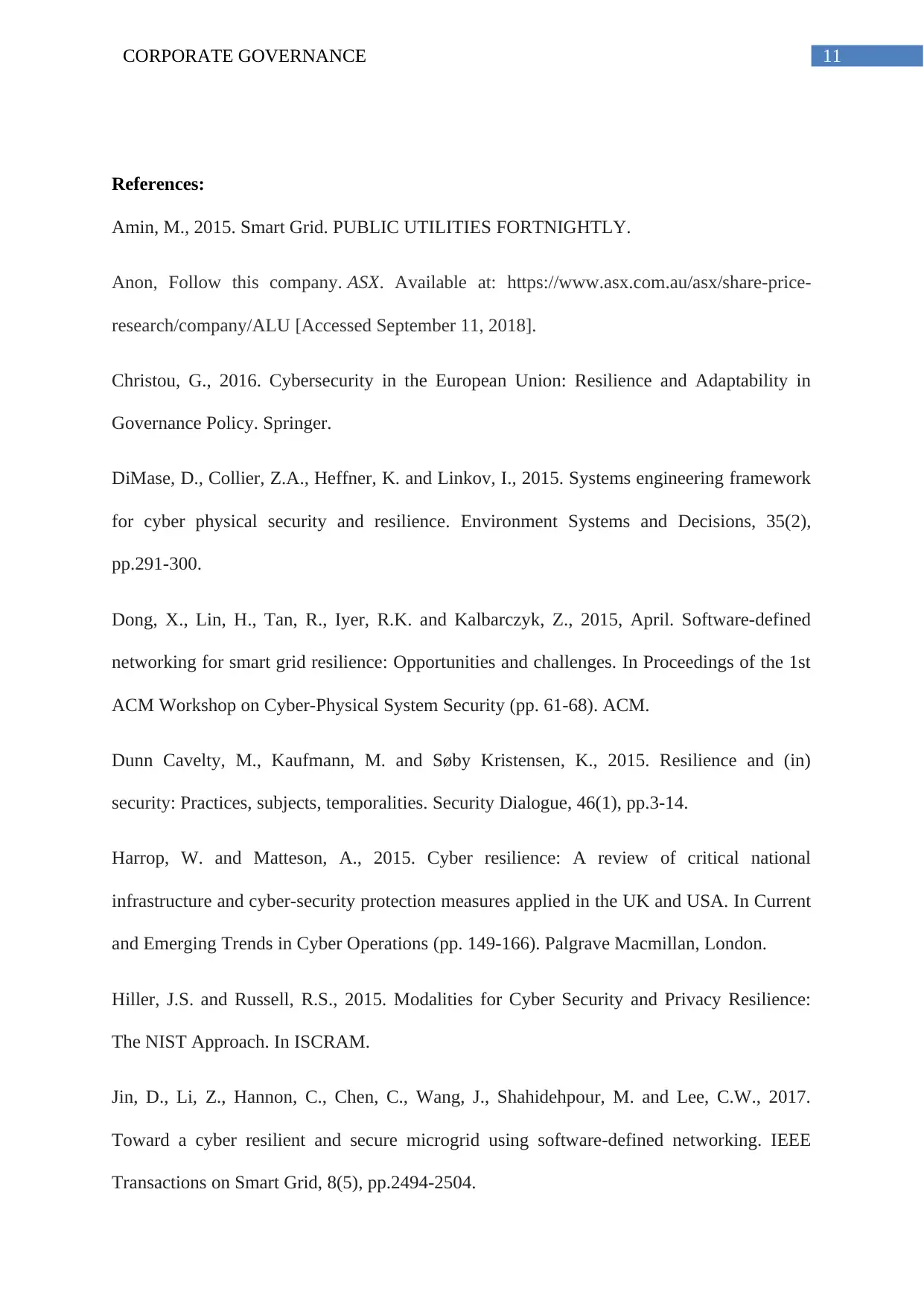
11CORPORATE GOVERNANCE
References:
Amin, M., 2015. Smart Grid. PUBLIC UTILITIES FORTNIGHTLY.
Anon, Follow this company. ASX. Available at: https://www.asx.com.au/asx/share-price-
research/company/ALU [Accessed September 11, 2018].
Christou, G., 2016. Cybersecurity in the European Union: Resilience and Adaptability in
Governance Policy. Springer.
DiMase, D., Collier, Z.A., Heffner, K. and Linkov, I., 2015. Systems engineering framework
for cyber physical security and resilience. Environment Systems and Decisions, 35(2),
pp.291-300.
Dong, X., Lin, H., Tan, R., Iyer, R.K. and Kalbarczyk, Z., 2015, April. Software-defined
networking for smart grid resilience: Opportunities and challenges. In Proceedings of the 1st
ACM Workshop on Cyber-Physical System Security (pp. 61-68). ACM.
Dunn Cavelty, M., Kaufmann, M. and Søby Kristensen, K., 2015. Resilience and (in)
security: Practices, subjects, temporalities. Security Dialogue, 46(1), pp.3-14.
Harrop, W. and Matteson, A., 2015. Cyber resilience: A review of critical national
infrastructure and cyber-security protection measures applied in the UK and USA. In Current
and Emerging Trends in Cyber Operations (pp. 149-166). Palgrave Macmillan, London.
Hiller, J.S. and Russell, R.S., 2015. Modalities for Cyber Security and Privacy Resilience:
The NIST Approach. In ISCRAM.
Jin, D., Li, Z., Hannon, C., Chen, C., Wang, J., Shahidehpour, M. and Lee, C.W., 2017.
Toward a cyber resilient and secure microgrid using software-defined networking. IEEE
Transactions on Smart Grid, 8(5), pp.2494-2504.
References:
Amin, M., 2015. Smart Grid. PUBLIC UTILITIES FORTNIGHTLY.
Anon, Follow this company. ASX. Available at: https://www.asx.com.au/asx/share-price-
research/company/ALU [Accessed September 11, 2018].
Christou, G., 2016. Cybersecurity in the European Union: Resilience and Adaptability in
Governance Policy. Springer.
DiMase, D., Collier, Z.A., Heffner, K. and Linkov, I., 2015. Systems engineering framework
for cyber physical security and resilience. Environment Systems and Decisions, 35(2),
pp.291-300.
Dong, X., Lin, H., Tan, R., Iyer, R.K. and Kalbarczyk, Z., 2015, April. Software-defined
networking for smart grid resilience: Opportunities and challenges. In Proceedings of the 1st
ACM Workshop on Cyber-Physical System Security (pp. 61-68). ACM.
Dunn Cavelty, M., Kaufmann, M. and Søby Kristensen, K., 2015. Resilience and (in)
security: Practices, subjects, temporalities. Security Dialogue, 46(1), pp.3-14.
Harrop, W. and Matteson, A., 2015. Cyber resilience: A review of critical national
infrastructure and cyber-security protection measures applied in the UK and USA. In Current
and Emerging Trends in Cyber Operations (pp. 149-166). Palgrave Macmillan, London.
Hiller, J.S. and Russell, R.S., 2015. Modalities for Cyber Security and Privacy Resilience:
The NIST Approach. In ISCRAM.
Jin, D., Li, Z., Hannon, C., Chen, C., Wang, J., Shahidehpour, M. and Lee, C.W., 2017.
Toward a cyber resilient and secure microgrid using software-defined networking. IEEE
Transactions on Smart Grid, 8(5), pp.2494-2504.
⊘ This is a preview!⊘
Do you want full access?
Subscribe today to unlock all pages.

Trusted by 1+ million students worldwide
1 out of 13
Related Documents
Your All-in-One AI-Powered Toolkit for Academic Success.
+13062052269
info@desklib.com
Available 24*7 on WhatsApp / Email
![[object Object]](/_next/static/media/star-bottom.7253800d.svg)
Unlock your academic potential
Copyright © 2020–2025 A2Z Services. All Rights Reserved. Developed and managed by ZUCOL.





